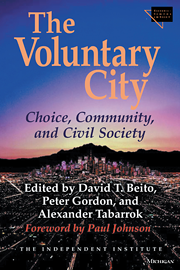When thousands of Chicago property owners went on a tax strike, the mayor threatened to cut off their water.
---------------
Many historians depict the Great Depression as a turning point when bitter economic realities finally led the middle class to break from laissez-faire tradition and demand bigger government. This is not entirely untrue, but it’s only part of what happened.
In its initial phase, the Depression also spawned a powerful movement for smaller government that included tax revolts. These revolts were not only more widespread but often more extreme than any sponsored by the tea party.
Depression-era taxpayers had perhaps even greater reason to be angry than their modern counterparts. Property values plummeted after 1929 but tax reassessments lagged. Overall, taxes nearly doubled to 21.1% of national income in 1932 from 11.6% in 1929, according to a 1940 Tax Policy Institute report.
Meanwhile, unemployment skyrocketed. Local property tax delinquency rose to a record (still standing) of 26.3% in 1933, from 10.1% in 1930. In many places, the tax system broke down and payment became almost voluntary. Throughout the country, Americans formed “taxpayers’ leagues” to demand spending cuts, arguing that since they had tightened their belts, politicians should too. According to an article in the National Municipal Review, at least 3,000 such groups had emerged by 1933 compared to only 47 in 1927. Because of tax league pressure, 19 states and numerous localities brought property levies under control by capping mill rates or limiting overall property taxes to a percentage of assessed value.
In 1932, New York Times journalist Anne O’Hare McCormick noted that “the nearest thing to a political revolution in the country is the tax revolt. . . . Taxpayers are wrought up to the point of willingness to give up public services. ‘We’ll do without county agents,’ they say. ‘We’ll give up the public health service.’” The head of the International City Managers Association bemoaned that, “There seems to be no game laws of any kind to protect public officers and the establishment we call government. Taxes have been assailed as economic waste and those who spend tax money have been pictured as wastrels.”
While most tax leaguers emphasized conventional legal approaches, a few pressed more radical measures. The best known was the Association of Real Estate Taxpayers in Chicago, which led one of the largest tax strikes in American history. At its height in 1933, it had 30,000 paid members, a budget of $600,000, and a weekly radio show. The strikers so angered Mayor Anton Cermak in 1932 that he threatened to cut off their city water. During a special visit to Washington, D.C., Cermak implored Congress to send “money now or militia later.” It did neither.
Condemned as “anarchists” and “public enemies,” the strikers, as well as mainstream tax leaguers, faced a level of invective that matched any endured by tea partiers. Noting that the city had a 40% tax delinquency, the head of an organization of Chicago school principals charged “Forty percent citizenship is no less dangerous and perilous to the government of America today than it was in the days of Benedict Arnold.”
By the middle of the 1930s, the tax revolt was largely over. Tax leaguers achieved property tax relief, mainly due to the imposition of new post-Prohibition “sin” taxes, mostly on alcohol. But the relief was only short term.
Moreover, tax leaguers often proved unable to respond to counterattacks and waffled when proposing specific areas to cut. Progressive “good government” reformers brilliantly found ways to channel lingering tax-revolt sentiment into relatively harmless proposals to make government more “efficient” rather than cut it down. New Deal administrators also contributed to the demise of the movement by denying aid to localities “hampered” by tax limitation laws, and by requiring any mortgagor to give priority to back taxes.
While the tea party and the Depression-era tax revolt show obvious parallels, several differences stand out. Tax delinquency since the onset of the recession has crept higher, but it is nowhere close to 1930s levels. Few tea partiers have contemplated tax strikes and, even if they did, the obstacles to such a strategy are now much greater. In the 1930s, for example, property owners paid taxes directly to the government. Today a homeowner agrees to pay the taxes he owes to the holder of his mortgage, who remits them to the government.
No one wrote a more fitting epitaph to the Depression-era tax revolt than the famed writer and editor H.L. Mencken, who was no friend of taxation. Writing in the American Mercury in late 1933, Mencken noticed a rapid shift in attitude from a period when the taxpayer “began to yell for relief; worse began to refuse his tax bills” causing “a sort of reign of terror for public office holders,” to an era that upheld the doctrine that “every free born American deserves his whack at the public treasury.” Politicians, he added “believe in God again, and if not God, then at least in the New Deal. It has delivered them.”










